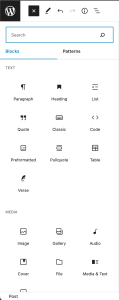The power of the block editor comes from the blocks themselves. The ability to add formatted content without having to include a shortcode, html, or fields within a custom page template adds abilities to site owners that has never been a part of WordPress. Not only does the block editor give this ability, but it allows you to add blocks in a variety of ways.
In The Content
Within the main content area there are two ways to add blocks, by clicking the “Add Block” button, or through typing a shortcut.

Clicking the “Add block” button seems to be the most straight forward for many users. Once clicked you are presented with some block suggestions, a search bar for searching for blocks, and a browse all button. The browse all button opens the block inserter panel, which we’ll get to in a bit.

The other way to add a block directly from within the content area is to type a slash “/” followed by the shortcut for your block. When you type “/” you will be prompted with suggestions.

Once prompted you can either click on a block or continue typing your shortcut, and hit return. So for example if you want to insert an image block you would type “/image”. Typically adding blocks in this way has become my go to, once you learn the text to type it makes adding the blocks seem much smoother and a more fluid editing experience in my opinion.
Another option for adding some blocks is through using some markdown. For example if you want to add an h2 heading you can type “##” press enter, and begin editing an h2 heading block.
Block Inserter
The block inserter can be opened in the top left of the page within the top toolbar.

Once toggled you will be presented a sidebar panel that looks something like this.

At the top you have a search field where you can search for a block, followed by tabs to look at blocks or block patterns. I’ve not mentioned block patterns yet, but it is something I want to get to in a later post, for now I’m just going to be looking at the blocks tab.
Under the blocks tab section you will see a listing of blocks, underneath different category headings such as “TEXT” which indicates text formatting blocks, or “media” which includes things like images, video, and audio related blocks. If you have plugins installed that support the block editor you could see some of their blocks within these default categories, or they may have added a category of their own. The block inserter though is essentially an easy all in one place to find the block you are needed to layout your content on the page.
WordPress is giving us tools to add and format our content in a number of ways with the block editor. It’s improved greatly since it’s initial release, and like any feature in WordPress will continue to improve over time. Set up a test post on your site and play around with each method of adding blocks. Go through and add each block just to see what it does and the ways you can edit with it. Keep in mind some themes may change the options of blocks so to get an even deeper understanding of them, try playing around with the blocks with different themes installed and activated. You may find you choose to make the block editor your “page builder” of choice.